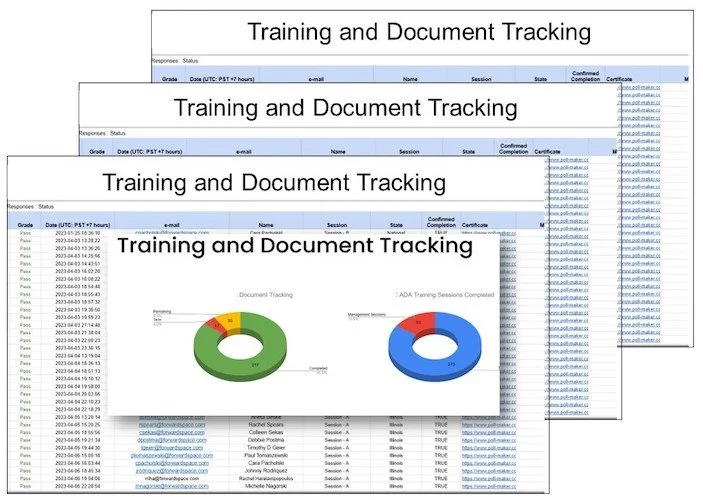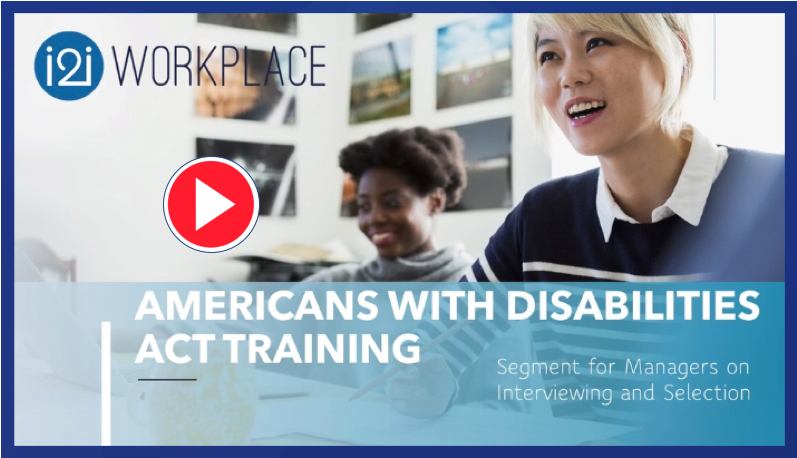ADA Disability Awareness and Sensitivity Training
Are you looking for ADA Disability Sensitivity and Awareness training to:
Increase employee awareness about the ADA
Respond to an EEOC inquiry with ADA sensitivity training
Enhance interactions with coworkers and the public
Educate managers about how to manage staff with disabilities
Updated for 2025 with Pregnancy/ADA crossover
99% of clients love our training - but don’t take their word for it - try a FREE TRAINING session on us!
ADA Disability Awareness and Sensitivity Training in 3 easy steps:
Step 1: Sign Up/Start Training
Start training in a day, no setup required..
Step 2: Completion Certificates
Certificates awarded to trainees.
Step 3: Easy Tracking/Compliance
Compliance made simple!

Here’s the value YOU gain from our ADA Disability Awareness and Sensitivity Training:
100% Satisfaction, money-back guarantee!
High Impact - Clients love the training! 99% of participants confirmed enhanced understanding and rated us 9.2 (of 10 NPS)!
High Value - less than $10/ employee
Flexible: available 24/7 Mobile Friendly
Full Year Access to training and resource library
Client Testimonials: Read their comments here.
“We should have more training like this!”
“I am very happy with the training. It’s easy to use and works well with over a thousand employees working in virtually every state”
"Happy to have found your company - you provide a cost-effective solution, and we appreciate your responsiveness to get us up and running quickly"
ADA Disability Awareness and Sensitivity Training 2025
To access the training, click on the graphic below to begin. You will be quizzed about your knowledge and at the end, will receive a certification of completion. Managers/supervisors take BOTH Session A and Session B.
Session A (ALL Staff): This training improves awareness of the legal, behavioral, and practical issues associated with ADA Compliance to create an accessible workplace for everyone.
Session B (Managers and Supervisors): Anyone who works with, interviews, manages, or ensures fairness in the workplace for people with disabilities should take Session A in addition to Session B. It includes an additional section on management issues relating to interviewing applicants and managing employees.
Select CC subtitles from the options menu as required or download the transcript.
DISCLAIMER: This document is provided for instructional purposes only and is not intended as legal advice. The information set forth in this document is provided for general use only to guide employers in making sound decisions about investigations. When conducting an investigation work with an employment law attorney or private investigator in order to comply with all applicable laws and regulations.

ADA Disabilities Act Awareness and Sensitivity Training
The staff training is for ALL employees focused on increasing awareness of disabled rights in the workplace and how to be fair and respectful. The management session provides additional insight for managers and supervisors working with, managing, or ensuring fairness in the workplace for people with disabilities. Each session includes a short video, test, and certificate of completion, along with administrative recordkeeping and tracking.
The staff training covers these topics:
Background of ADA and ADAAA including Title I, II, and III
Definitions of essential functions, marginal functions, “regarded as,” reasonable accommodations, and other terms
Ensuring consistency in interviewing, testing, and hiring processes
Practical actions to take to ensure respectful Interactions
Resources for further research
The Manager session covers these topics:
What questions to ask in an interview
Ensuring fairness in managerial decision-making
How to respond to accommodation requests
Leave as a reasonable accommodation
The interactive process
Anti-retaliation provisions

We will be honored to service your ADA Awareness and Sensitivity Training needs. Please let us know how we can help you and/or if you have any questions.
ADA Disability Requirements and Resources
For more specific information about ADA requirements affecting employment contact:
Equal Employment Opportunity Commission
P.O. Box 7033
Lawrence, Kansas 66044
(800) 669-4000 (Voice), (800) 669-6820 (TDD)
For more specific information about ADA requirements affecting public accommodations and State and local government services contact:
Department of Justice
Office on the Americans with Disabilities Act
Civil Rights Division
P.O. Box 66118
Washington, DC 20035-6118
(202) 514-0301 (Voice)
(202) 514-0381 (TDD)
(202) 514-0383 (TDD)
For more specific information about requirements for accessible design in new construction and alterations contact:
Architectural and Transportation Barriers
Compliance Board
1111 18th Street, NW
Suite 501
Washington, DC 20036
800-USA-ABLE
800-USA-ABLE ( TDD)
For more specific information about ADA requirements affecting transportation contact:
Department of Transportation
400 Seventh Street, SW
Washington, DC 20590
(202) 366-9305
(202) 755-7687 (TDD)
For more specific information about ADA requirements for telecommunications contact:
Federal Communications Commission
1919 M Street, NW
Washington, DC 20554
(202) 634-1837
(202) 632-1836 (TDD)
For more specific information about federal disability-related tax credits and deductions for business contact:
Internal Revenue Service
Department of the Treasury
1111 Constitution Avenue, NW
Washington, DC 20044
(202) 566-2000

Americans with Disabilities Act Background and History
AMERICANS WITH DISABILITIES ACT OF 1990
The Americans with Disabilities Act of 1990 (ADA) makes it unlawful to discriminate in employment against a qualified individual with a disability. The ADA also outlaws discrimination against individuals with disabilities in State and local government services, public accommodations, transportation and telecommunications. The law is enforced by the U.S. Equal Employment Opportunity Commission and State and local civil rights enforcement agencies that work with the Commission.
FIVE TITLES OF THE ADA
Title I – Of the five titles of the Americans with Disabilities Act (ADA), Title I of the ADA pertains to Employment. Under ADA Title I, covered entities shall not discriminate against a qualified individual with a disability. This applies to job application procedures, hiring, advancement and discharge of employees, worker's compensation, job training, and other terms, conditions, and privileges of employment.
Title II – Of the five titles of the Americans with Disabilities Act (ADA), Title II of the ADA pertains to State and Local Government (public entities). ADA Title II requires agencies to comply with regulations similar to Section 504 of the Rehabilitation Act. These rules cover access to all services, programs, or activities offered by the public entity, and extends coverage to public transportation entities. Access includes physical access described in the Uniform Federal Accessibility Standards or the ADA Standards for Accessible Design and access that might be obstructed by discriminatory policies or procedures of the entity.
Title III – Of the five titles of the Americans with Disabilities Act (ADA), Title III of the ADA pertains to Public Accommodations (private entities). Under ADA Title III, no individual may be discriminated against on the basis of disability with regards to the full and equal enjoyment of the goods, services, facilities, or accommodations of any place of public accommodation by any person who owns, leases (or leases to), or operates a place of public accommodation.
Title IV – Of the five titles of the Americans with Disabilities Act (ADA), Title IV of the ADA pertains to Telecommunications. ADA Title IV addresses telephone and television access for individuals with hearing and speech disabilities. Specific requirements under Title IV include: closed captioning of Federally funded public service announcements (PSA), and telephone companies must establish in-state and state-to-state telecommunications relay services (TRS) 24 hours a day, 7 days a week.
Title V – Of the five titles of the Americans with Disabilities Act (ADA), Title V of the ADA pertains to miscellaneous provisions, most of which apply to all titles of the ADA.
TITLE I OF ADA
Title I of the Americans with Disabilities Act of 1990 prohibits private employers, State and local governments, employment agencies and labor unions from discriminating against qualified individuals with disabilities in job application procedures, hiring, firing, advancement, compensation, job training, and other terms, conditions, and privileges of employment. The ADA covers employers with 15 or more employees, including State and local governments. It also applies to employment agencies and to labor organizations.
TITLE II
Title II of the ADA prevents local public organizations from discriminating against people with disabilities. This means organizations like the local school system, public train, public housing, and other city and state government buildings.
For example, Title II is the reason your local library is required to have a ramp or elevator, and public housing must accommodate service animals, even if pets are not permitted.
Section 508 of the law requires government agencies to provide access to electronic content, including videos, PDFs, and other online content. For businesses and government agencies, it includes adding captions to videos or providing transcripts, according to Digital.gov.
TITLE III of the ADA
Title III of the ADA focuses on private businesses, such as hotels, restaurants, theatres, grocery stores, and hardware stores. If you own a private business, this is the part you’ll want to pay attention to.
Title III requires businesses to provide services in an “integrated setting,” which means a restaurant, for example, can’t say people in wheelchairs can only come on the third Wednesday of the month.
Title III also requires businesses to get rid of discriminatory eligibility standards for accessibility, make reasonable accommodations, and provide auxiliary aids or services when possible to ensure effective communication.
Unlike state or local governments, private businesses may not have to comply with the ADA if it presents an “undue burden.” For example, a restaurant in a historic building might not have to install an elevator if it would require renovating the entire building.
AMENDMENTS TO THE ADA WITH THE ADAAA 2008
Since The Americans with Disabilities Act: Your Responsibilities as an Employer was published, the Supreme Court has ruled that the determination of whether a person has an ADA "disability" must take into consideration whether the person is substantially limited in performing a major life activity when using a mitigating measure. This means that if a person has little or no difficulty performing any major life activity because s/he uses a mitigating measure, then that person will not meet the ADA's first definition of "disability." The Supreme Court's rulings were in Sutton v. United Airlines, Inc., 527 U.S. ____ (1999), and Murphy v. United Parcel Service, Inc., 527 U.S. ____ (1999).
As a result of the Supreme Court's ruling, this document's guidance on mitigating measures, found in the section "Additional Questions and Answers on the Americans with Disabilities Act," is superseded. Following the Supreme Court's ruling, whether a person has an ADA "disability" is determined by taking into account the positive and negative effects of mitigating measures used by the individual. The Supreme Court's ruling does not change anything else in this document.
For more information on the Supreme Court rulings and their impact on determining whether specific individuals meet the definition of "disability," consult the Instructions for Field Offices: Analyzing ADA Charges After Supreme Court Decisions Addressing "Disability" and "Qualified," which can be found on EEOC's website at www.eeoc.gov.
ENFORCEMENT AND REMEDIES OF THE ADA
The provisions of the ADA are enforced by the U.S. Equal Employment Opportunity Commission. Individuals who believe they have been discriminated against on the basis of their disability can file a charge with the EEOC at any of its offices located throughout the United States. See resources for details, or check your EEO is the Law employment poster.
A charge of discrimination must be filed within 180 days of the discrimination, unless there is a state or local law that also provides relief for discrimination on the basis of disability. In those cases, the complainant has 300 days to file a charge.
The Commission will investigate and initially attempt to resolve the charge through conciliation, following the same procedures used to handle charges of discrimination filed under Title VII of the Civil Rights Act of 1964. The ADA also incorporates the remedies contained in Title VII. These remedies include hiring, promotion, reinstatement, back pay, and attorneys fees. Reasonable accommodation is also available as a remedy under the ADA.
OTHER LEGAL PROTECTIONS FOR DISABLED EMPLOYEES
Job discrimination against people with disabilities is illegal if practiced by:
private employers,
state and local governments,
employment agencies,
labor organizations, and
labor-management committees.
All employers, including state and local government employers, with 15 or more employees
WHO IS PROTECTED BY THE AMERICANS WITH DISABILITIES ACT?
Title I of the ADA protects qualified individuals with disabilities from employment discrimination. Under the ADA, a person has a disability if he has a physical or mental impairment that substantially limits a major life activity. The ADA also protects individuals who have a record of a substantially limiting impairment, and people who are regarded as having a substantially limiting impairment.
To be protected under the ADA, an individual must have, have a record of, or be regarded as having a substantial, as opposed to a minor, impairment. A substantial impairment is one that significantly limits or restricts a major life activity such as hearing, seeing, speaking, breathing, performing manual tasks, walking, caring for oneself, learning, or working.
An individual with a disability must also be qualified to perform the essential functions of the job with or without reasonable accommodation, in order to be protected by the ADA. This means that the applicant or employee must:
satisfy your job requirements for educational background, employment experience, skills, licenses, and any other qualification standards that are job-related; and
be able to perform those tasks that are essential to the job, with or without reasonable accommodation.
The ADA does not interfere with your right to hire the best-qualified applicant. Nor does the ADA impose any affirmative action obligations. The ADA simply prohibits you from discriminating against a qualified applicant or employee because of her disability.
DEFINITIONS IN THE ADA
WHAT IS A DISABILITY?
A physical or mental impairment that substantially limits one or more major life activities, a record of such an impairment, or being regarded as having such an impairment.
DEFINITION OF “MAJOR LIFE ACTIVITY”
Major life activity – An activity that an average person can perform with little or no difficulty.
MITIGATING MEASURES
Mitigating measures – A measure utilized (such as medication or glasses) that eliminates or reduces the symptoms of an impairment so it is no longer substantially limiting.
DEFINITION OF “REGARDED AS A DISABILITY”
“Regarded as” means that the person either:
Has an impairment that does not substantially limit a major life activity;
Has an impairment that substantially limits a major life activity only as a result of the attitudes of others toward them; or
Does not have any impairment, but is treated by an entity as having an impairment.
MARGINAL FUNCTIONS
Marginal functions – Duties of a job that are not absolutely necessary for the job being performed.
HOW TO DETERMINE ESSENTIAL FUNCTIONS UNDER THE ADA
Essential functions are the basic job duties that an employee must be able to perform, with or without reasonable accommodation. You should carefully examine each job to determine which functions or tasks are essential to performance. (This is particularly important before taking an employment action such as recruiting, advertising, hiring, promoting, or firing).
Factors to consider in determining if a function is essential include:
whether the reason the position exists is to perform that function,
the number of other employees available to perform the function or among whom the performance of the function can be distributed, and
the degree of expertise or skill required to perform the function.
Your judgment as to which functions are essential, and a written job description prepared before advertising or interviewing for a job will be considered by EEOC as evidence of essential functions. Other kinds of evidence that EEOC will consider include:
the actual work experience of present or past employees in the job,
the time spent performing a function,
the consequences of not requiring that an employee perform a function, and
the terms of a collective bargaining agreement.
ILLEGAL DRUG USERS
Anyone who is currently using drugs illegally is not protected by the ADA and may be denied employment or fired on the basis of such use. The ADA does not prevent employers from testing applicants or employees for current illegal drug use, or from making employment decisions based on verifiable results. A test for the illegal use of drugs is not considered a medical examination under the ADA; therefore, it is not a prohibited pre-employment medical examination and you will not have to show that the administration of the test is job-related and consistent with business necessity. The ADA does not encourage, authorize or prohibit drug tests.
Do Individuals Who Use Drugs Illegally Have Rights Under The Ada?
INTERVIEWING AND TESTING, AND HIRING
WHEN INTERVIEWING DON’T FORGET THESE RESTRICTIONS UNDER THE ADA
It is unlawful to:
ask an applicant whether she is disabled or about the nature or severity of a disability, or
to require the applicant to take a medical examination before making a job offer.
You can ask an applicant questions about their ability to perform job-related functions, as long as the questions are not phrased in terms of a disability. You can also ask an applicant to describe or to demonstrate how, with or without reasonable accommodation, the applicant will perform job-related functions.
Employers may not ask disability-related questions or conduct medical examinations until after they make a conditional job offer to an applicant.
Employers have an obligation to make reasonable accommodations to enable applicants with disabilities to participate in the interview process.
Employers cannot ask whether an applicant has a physical or mental impairment, has received workers’ compensation, or was ever addicted to illegal drugs.
Known disability: can ask how we can accommodate you, but cannot ask anything else
Questions to avoid in an interview
INTERVIEWING TOPICS TO AVOID UNDER THE ADA
For example: topics on protected information such as FMLA, ADA, medications, need for accommodations, etc.
Don’t get nervous and rattled.
Firmly and confidently state the following sample verbiage:
“That information will not be used to determine whether you move forward in the hiring process.”
“If you move forward in the hiring process, you can work with HR on an appropriate accommodation.”
POST-OFFER MEDICAL EXAMINATIONS UNDER THE ADA
After a job offer is made and prior to the commencement of employment duties, you may require that an applicant take a medical examination if everyone who will be working in the job category must also take the examination. You may condition the job offer on the results of the medical examination. However, if an individual is not hired because a medical examination reveals the existence of a disability, you must be able to show that the reasons for exclusion are job-related and necessary for the conduct of your business. You also must be able to show that there was no reasonable accommodation that would have made it possible for the individual to perform the essential job functions.
Once you have hired an applicant, you cannot require a medical examination or ask an employee questions about disability unless you can show that these requirements are job-related and necessary for the conduct of your business. You may conduct voluntary medical examinations that are part of an employee health program.
The results of all medical examinations or information from inquiries about a disability must be kept confidential and maintained in separate medical files. You may provide medical information required by State workers' compensation laws to the agencies that administer such laws.
CONSISTENT HIRING DECISIONS UNDER THE ADA
Q. Under the ADA, can an employer refuse to hire an individual or fire a current employee who uses drugs illegally?
A. Yes. Individuals who currently use drugs illegally are specifically excluded from the ADA's protections. However, the ADA does not exclude:
persons who have successfully completed or are currently in a rehabilitation program and are no longer illegally using drugs, and
persons erroneously regarded as engaging in the illegal use of drugs.
Q. Can I consider health and safety in deciding whether to hire an applicant or retain an employee with a disability?
A. The ADA permits an employer to require that an individual not pose a direct threat to the health and safety of the individual or others in the workplace. A direct threat means a significant risk of substantial harm. You cannot refuse to hire or fire an individual because of a slightly increased risk of harm to himself or others. Nor can you do so based on a speculative or remote risk. The determination that an individual poses a direct threat must be based on objective, factual evidence regarding the individual's present ability to perform essential job functions. If an applicant or employee with a disability poses a direct threat to the health or safety of himself or others, you must consider whether the risk can be eliminated or reduced to an acceptable level with reasonable accommodation.
Q. If I have several qualified applicants for a job, does the ADA require that I hire the applicant with a disability?
A. No. You may hire the most qualified applicant. The ADA only makes it unlawful for you to discriminate against a qualified individual with a disability on the basis of disability.
HOW TO MANAGE SPECIFIC SITUATIONS PROTECTED BY THE ADA - MEDICATIONS
Q. One of my employees is a diabetic but takes insulin daily to control his diabetes. As a result, diabetes has had no significant impact on his employment. Is he protected by the ADA?
A. Yes. The determination as to whether a person has a disability under the ADA is made without regard to mitigating measures, such as medications, auxiliary aids, and reasonable accommodations. If an individual has an impairment that substantially limits a major life activity, she is protected under the ADA, regardless of the fact that the disease or condition or its effects may be corrected or controlled.
HOW TO MANAGE SPECIFIC SITUATIONS PROTECTED BY THE ADA - HIV/AIDS
Q. Does the ADA cover people with AIDS?
A. Yes. The legislative history indicates that Congress intended the ADA to protect persons with AIDS and HIV disease from discrimination.
REASONABLE ACCOMMODATIONS
A reasonable accommodation is any change or adjustment to a job or work environment that permits a qualified applicant or employee with a disability to participate in the job application process, to perform the essential functions of a job, or to enjoy benefits and privileges of employment equal to those enjoyed by employees without disabilities. For example, reasonable accommodation may include:
acquiring or modifying equipment or devices,
job restructuring,
part-time or modified work schedules,
reassignment to a vacant position,
adjusting or modifying examinations, training materials or policies,
providing readers and interpreters, and
making the workplace readily accessible to and usable by people with disabilities.
Reasonable accommodation also must be made to enable an individual with a disability to participate in the application process, and to enjoy benefits and privileges of employment equal to those available to other employees.
It is a violation of the ADA to fail to provide reasonable accommodation to the known physical or mental limitations of a qualified individual with a disability, unless to do so would impose an undue hardship on the operation of your business. Undue hardship means that the accommodation would require significant difficulty or expense.
Reasonable accommodation – A modification or adjustment to a job, the work environment, or the way things usually are done that enables a qualified individual with a disability to enjoy an equal employment opportunity. For example:
Modifications or adjustments to a job application process that enable a qualified applicant with a disability to be considered for the position such qualified applicant desires; or
Modifications or adjustments to the work environment, or to the manner or circumstances under which the position held or desired is customarily performed, that enable a qualified individual with a disability to perform the essential functions of that position; or
Modifications or adjustments that enable a covered entity's employee with a disability to enjoy equal benefits and privileges of employment as are enjoyed by its other similarly situated employees without disabilities.
WHAT IS THE BEST WAY TO IDENTIFY A REASONABLE ACCOMMODATION?
Frequently, when a qualified individual with a disability requests a reasonable accommodation, the appropriate accommodation is obvious. The individual may suggest a reasonable accommodation based upon her own life or work experience. However, when the appropriate accommodation is not readily apparent, you must make a reasonable effort to identify one. The best way to do this is to consult informally with the applicant or employee about potential accommodations that would enable the individual to participate in the application process or perform the essential functions of the job. If this consultation does not identify an appropriate accommodation, you may contact the EEOC, State or local vocational rehabilitation agencies, or State or local organizations representing or providing services to individuals with disabilities. Another resource is the Job Accommodation Network (JAN). JAN is a free consultant service that helps employers make individualized accommodations. The telephone number is 1-800-526-7234.
WHEN DOES A REASONABLE ACCOMMODATION BECOME AN UNDUE HARDSHIP?
It is not necessary to provide a reasonable accommodation if doing so would cause an undue hardship. Undue hardship means that an accommodation would be unduly costly, extensive, substantial, or disruptive, or would fundamentally alter the nature or operation of the business. Among the factors to be considered in determining whether an accommodation is an undue hardship are the cost of the accommodation, the employer's size, financial resources, and the nature and structure of its operation.
If a particular accommodation would be an undue hardship, you must try to identify another accommodation that will not pose such a hardship. If cost causes undue hardship, you must also consider whether funding for an accommodation is available from an outside source, such as a vocational rehabilitation agency, and if the cost of providing the accommodation can be offset by state or federal tax credits or deductions. You must also give the applicant or employee with a disability the opportunity to provide the accommodation or pay for the portion of the accommodation that constitutes an undue hardship.
Q. Am I obligated to provide a reasonable accommodation for an individual if I am unaware of her physical or mental impairment?
A. No. An employer's obligation to provide reasonable accommodation applies only to known physical or mental limitations. However, this does not mean that an applicant or employee must always inform you of a disability. If a disability is obvious, e.g., the applicant uses a wheelchair, the employer "knows" of the disability even if the applicant never mentions it.
Q. How do I determine whether a reasonable accommodation is appropriate and the type of accommodation that should be made available?
A. The requirement generally will be triggered by a request from an individual with a disability, who frequently can suggest an appropriate accommodation. Accommodations must be made on a case-by-case basis because the nature and extent of a disabling condition and the requirements of the job will vary. The principal test in selecting a particular type of accommodation is that of effectiveness, i.e., whether the accommodation will enable the person with a disability to perform the essential functions of the job. It need not be the best accommodation or the accommodation the individual with a disability would prefer, although primary consideration should be given to the preference of the individual involved. However, as the employer, you have the final discretion to choose between effective accommodations, and you may select one that is the least expensive or easier to provide.
Q. When must I consider reassigning an employee with a disability to another job as a reasonable accommodation?
A. When an employee with a disability is unable to perform her present job even with the provision of reasonable accommodation, you must consider reassigning the employee to an existing position that she can perform with or without reasonable accommodation. The requirement to consider reassignment applies only to employees and not to applicants. You are not required to create a position or to bump another employee in order to create a vacancy. Nor are you required to promote an employee with a disability to a higher-level position.
Q. What if an applicant or employee refuses to accept an accommodation that I offer?
A. The ADA provides that an employer cannot require a qualified individual with a disability to accept an accommodation that is neither requested nor needed by the individual. However, if a necessary reasonable accommodation is refused, the individual may be considered not qualified.
WORKPLACE ACCESSIBILITY
ACCESS TO FACILITIES
Q. If our business has a health spa in the building, must it be accessible to employees with disabilities?
A. Yes. Under the ADA , workers with disabilities must have equal access to all benefits and privileges of employment that are available to similarly situated employees without disabilities. The duty to provide reasonable accommodation applies to all non-work facilities provided or maintained by you for your employees. This includes cafeterias, lounges, auditoriums, company-provided transportation and counseling services. If making an existing facility accessible would be an undue hardship, you must provide a comparable facility that will enable a person with a disability to enjoy benefits and privileges of employment similar to those enjoyed by other employees, unless this would be an undue hardship.
ACCESS TO TRAINING UNDER THE ADA
Q. If I contract for a consulting firm to develop a training course for my employees, and the firm arranges for the course to be held at a hotel that is inaccessible to one of my employees, am I liable under the ADA?
A. Yes. An employer may not do through a contractual or other relationship what it is prohibited from doing directly. You would be required to provide a location that is readily accessible to, and usable by your employee with a disability unless to do so would create an undue hardship.
ACCESS TO FACILITIES UNDER THE ADA
Q. What are my responsibilities as an employer for making my facilities accessible?
A. As an employer, you are responsible under Title I of the ADA for making facilities accessible to qualified applicants and employees with disabilities as a reasonable accommodation, unless this would cause undue hardship. Accessibility must be provided to enable a qualified applicant to participate in the application process, to enable a qualified individual to perform essential job functions, and to enable an employee with a disability to enjoy benefits and privileges available to other employees. However, if your business is a place of public accommodation (such as a restaurant, retail store, or bank) you have different obligations to provide accessibility to the general public, under Title III of the ADA. Title III also will require places of public accommodation and commercial facilities (such as office buildings, factories, and warehouses) to provide accessibility in new construction or when making alterations to existing structures.
REGARDING INSURANCE FOR PEOPLE WITH DISABILITIES
Q. Am I required to provide additional insurance for employees with disabilities?
A. No. The ADA only requires that you provide an employee with a disability equal access to whatever health insurance coverage you provide to other employees. For example, if your health insurance coverage for certain treatments is limited to a specified number per year, and an employee, because of a disability, needs more than the specified number, the ADA does not require that you provide additional coverage to meet that employee's health insurance needs. The ADA also does not require changes in insurance plans that exclude or limit coverage for pre-existing conditions.
RESPECTFUL PRACTICES TO CONSIDER WHEN INTERACTING WITH PEOPLE WITH DISABILITIES
Be cautious of using outdated, offensive terms. Words like “handicapped” or “wheelchair-bound” are not acceptable terms to use today. Many wheelchair users don’t like the word “bound” because of its negative connotation, meaning they’re tied down to the chair. Wheelchairs allow freedom and mobility. “Wheelchair accessible” is the more appropriate term to use. Handicapped is a broad and general term that many people think implies helplessness. Disabled is more appropriate. ALSO, AVOID INFLICTED WITH, VICTIM OF, SUFFERS FROM AS TERMS.
Communication Basics
People who have never interacted with a person who has a mental or physical disability may think of the exchange as intimidating or nerve-wracking. They might worry about what to talk about or how to avoid staring. These concerns are understandable, but it’s important to realize people with disabilities should be treated the same as everyone else.
The most important part of interacting with someone who has a disability is seeing that person for whom he or she is, and not what disability that person has. What it boils down to is having a sense of disability awareness and disability etiquette. And to help raise awareness Vantage Mobility has created some useful tips to remember:
Seek to understand the person and his or her disability before expecting to be understood. There may be times when you try your best to be respectful of a person with a disability and it backfires. You may be perceived incorrectly or perhaps offend someone unintentionally. Before getting angry and thinking, “They should understand I wasn’t trying to be rude,” step back from the situation and understand there could be many contributing factors to why that person got upset.
Speak to the person before his or her caregiver. Someone with a distorted figure or speech impediment as a result of a physical disability is often ignored because people assume he or she has a mental disability and won’t understand. Always speak to the person with a disability before approaching the caregiver; it’s the respectful thing to do. By approaching the caregiver first, the person with the disability assumes you see him or her as unequal or incapable; it damages the relationship immediately.
Adjust posture to be eye-level. The height difference between people in wheelchairs and able-bodies can create an unspoken feeling of superiority and inferiority. To be safe, sit or stand at eye level with the person who has a disability when it is appropriate and possible. Finding a table to sit at is a great option because it can eliminate any visible differences, such as a wheelchair. Sitting in a chair (with or without a table) is also better than kneeling, which may cause the person in a wheelchair to feel like a child.
Make eye contact; never avoid someone with a disability. People who fear they could do or say something unintentionally disrespectful toward a person with a disability will sometimes default to ignoring that person altogether. Never do this. People with disabilities are human, and their existence deserves acknowledgment. Any human would feel terrible being ignored; it’s never the right choice.
Ask if he or she needs assistance before providing it. Don’t try to accommodate every last need of someone with a disability in attempt to be respectful. The better choice is to ask, “Is there anything I can help you with?” or, “Do you want me to get the door?” Helping before asking implies he or she is incapable and can offend the person, especially if they’ve worked hard to be able to care for themselves.
Find commonalities before thinking about differences. Common ground is the base of all human connections; once you’ve found something in common, then you can deal with the differences. For example, a person in a wheelchair may use a wheelchair lift and hand controls to transport into a car and drive. Rather than thinking about how you and this person drive differently, focus on the commonality: both of you drive. In this instance, the difference doesn’t matter.
Do not victimize people with disabilities. Referring to someone as a “spinal cord injury victim,” or “cerebral palsy victim,” takes away that person’s power. It abdicates them of their strength and ability to overcome because the emphasis is on what happened to them, as opposed to what they did about it. It would be more appropriate to refer to someone with a disability as a “survivor.”
Don’t assume they see their disability as a tragedy. Many people with disabilities have worked through the tough emotions to be happy and content with their lives. A seemingly harmless statement like, “I’m so sorry that happened to you,” or something of that nature can make a person with a disability feel sad and sorry.
Do not underestimate the abilities of someone with a disability. Many people with disabilities are capable of caring for themselves without any assistance. They’ve spent a long time adjusting to a different way of life – be it purchasing wheelchair accessible vehicles for transportation, calling ahead to make sure a restaurant is wheelchair accessible, installing tile in their homes to avoid wheelchair friction on the carpet, etc. They understand what they’re capable of and what their limitations are, so don’t worry about taking care of them.
Source: Vantage Mobility.com







